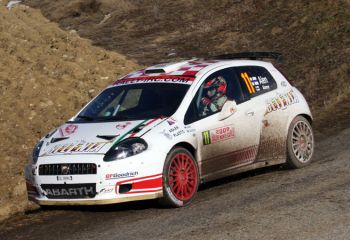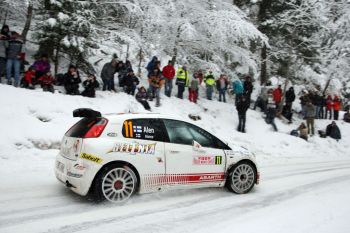

 |
|
Veteran rally star Giandomenico Basso
(middle) salvaged Abarth honour on the Monte
Carlo Rally last month with a fighting fifth
place finish while his 25-year-old team mate
Anton Alén (top and bottom) agonising
retired with the finishing ramp in sight. |
|
|
|
From the
treacherous snow and ice of the 78th Monte Carlo Rally
last month the Abarth factory team now switches to a
very rough gravel surface on the other side of the world
as the Intercontinental Rally Challenge (IRC) goes into
the final countdown to the start of the 29th Rally
Internacional de Curitiba in eight days time.
Italian Fiat
Group veteran rally driver Giandomenico Basso, who salvaged
Abarth's honour in Monte Carlo with a fighting fifth place
finish, and his 25-year-old team mate Anton Alén, will make
up a two-car Super 2000 challenge from the Abarth factory
that will seek to quickly reign in the advantage that
Peugeot walked away from Monte Carlo with.
And in
preparation for the tough new challenge of Brazil, Basso, Alén, and
the team's new 2009 signing Luca
Rossetti, all spent time behind the wheel of the
latest-specification Grande Punto Abarth on some gravel stages
near Siena in Tuscany earlier this month. The test aimed
to develop some new running gear on the Grande Punto Abarth, and
also to reacquaint the drivers with gravel following the
ice and snow of the Monte Carlo Rally.
The first two
rounds of this year’s Intercontinental Rally Challenge could
not provide a greater contrast to each other. From the icy
rigours of Monte Carlo the competitors swiftly move to
gravel on the other side of the world, where temperatures
are set to be dry and warm. In order to make the transition,
a number of changes need to be made to the cars.
The biggest
change between a gravel and asphalt set-up is that the cars
ride much higher on gravel. This is because the roads are
rougher, so the cars need to be tall enough to pass over
most surface obstacles, and provide enough suspension travel
to absorb jumps and bumps. As a result the suspension set-up
on each car for gravel tends to be a lot softer than it is
for an asphalt surface, enabling the cars to flow better
over the rough roads.
The tyres are also very different. Gravel tyres are tougher,
in order to resist punctures, and they also feature a
distinctive deeply-grooved pattern to expel dirt, dust and
debris. The wheels and brakes on gravel tend to be smaller
than those seen on asphalt rallies, as the braking forces
are less because the cars slide more (due to the loose
surfaces involved offering less traction and grip). As a
result, the physical forces exerted upon the drivers tend to
be smaller, thanks to the lower G-forces that are generated.
However, one extra problem that the cars will have to face
in Brazil is cooling. The low ambient temperatures in Monte
Carlo meant that it was comparatively easy for engines and
brakes to stay cool, but this will not be the case in the
higher temperatures of Brazil – where it could be easy for
the cars to overheat. Although there are many subtle
differences between an asphalt and a gravel set-up, a
skilled group of mechanics can swap a car from one
configuration to another in just a couple of hours. This is
will have taken place back at base, before the cars were all
shipped off to South America last earlier this month.
|